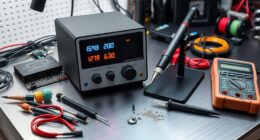Essential canning kits are perfect for your food preservation needs, no matter your experience level. For beginners, the Norpro Canning Essentials Kit at $19 includes all the basics, like tongs and a jar funnel. If you're ready for more, the Granite Ware Canner Kit offers a big 21.5-quart capacity and essential tools for $78. You might even consider the All American Pressure Canner, ideal for low-acid foods, though it's pricier at $339. Each kit typically includes jar lifters and bubble poppers to guarantee success. Stick around to find out which kit is best for your canning journey!
Key Takeaways
- Canning kits, like the Norpro Essentials Kit and Granite Ware Canner Kit, provide essential tools for food preservation at various price points.
- Water bath canning is suitable for high-acid foods, while pressure canning is necessary for low-acid foods, ensuring food safety.
- Safety guidelines emphasize using tested recipes and inspecting jars to prevent contamination and health risks during canning.
- Quality canning supplies, including jars, jar lifters, and funnels, enhance the canning experience and ensure proper sealing.
- Community resources, such as workshops and online forums, offer support and knowledge-sharing for canners of all skill levels.
Overview of Canning Kits

Using a canning kit is a great way to preserve your favorite foods while ensuring they stay safe for consumption. Canning kits typically come with all the necessary tools, including jars, lids, and a canner, making the process convenient and efficient. Whether you’re canning fruits, vegetables, or homemade jams, using a canning kit allows you to enjoy your favorite foods all year round. In addition to using a canning kit, it’s important to follow proper longterm food storage tips to ensure your canned goods stay fresh and safe to eat. This includes storing them in a cool, dark place and checking for any signs of spoilage before consumption.
These kits are crucial for anyone interested in food preservation, regardless of skill level. For beginners, the Norpro Canning Essentials Kit is affordable at just $19 and includes handy tools like tongs and a jar funnel.
If you're looking for something more extensive, the Granite Ware Canner Kit offers a 21.5-quart capacity and a five-piece toolset for $78.
For those who want to can low-acid foods safely, the All American Pressure Canner, priced at $339, features a reliable gasketless seal.
Each kit includes essential tools like jar lifters and bubble poppers, ensuring a successful canning process.
Canning Methods Explained

Understanding different canning methods is key to effectively preserving your food. Each method has its unique approach, guaranteeing your preserved goods taste great and stay safe.
Here's a quick overview of the main canning methods you can use:
- Water Bath Canning: Perfect for high-acid foods like fruits and pickles. Submerge jars in boiling water at 212°F.
- Pressure Canning: Essential for low-acid foods such as vegetables and meats. This method requires higher temperatures of at least 240°F.
- Jar Preparation: Always sterilize jars to prevent contamination before filling them.
- Headspace: Maintain a headspace of 1/4 to 1 inch in jars to allow for food expansion during processing.
Choosing the right method guarantees your canning success and delicious results!
Safety Guidelines for Canning

When it comes to canning, adhering to strict safety guidelines is essential for preserving food effectively and preventing health risks. Always stick to scientifically tested recipes to avoid the dangers of Clostridium botulinum.
Inspect your jars for any cracks or chips, as these can compromise the seal; it's best to use new lids for an airtight seal. Be certain to sanitize your jars and work surfaces thoroughly to prevent contamination.
Additionally, maintain proper headspace in your jars to guarantee a good seal. After canning, store your jars in a cool, dark place, and label them with dates.
Key Canning Supplies

Key canning supplies are essential for anyone looking to preserve food safely and effectively.
Having the right tools can make your canning experience smoother and more enjoyable. Here are four must-have items for your canning kit:
- Canning Jars: Choose quality glass jars with proper sealing lids to guarantee freshness.
- Jar Lifter: This handy tool helps you safely lift hot jars from boiling water without burns.
- Bubble Popper: Use this tool to eliminate air bubbles in jars, assuring a proper seal.
- Funnel: A wide-mouth funnel makes filling jars mess-free and easy, helping you avoid spills.
With these key supplies, you'll be well-equipped to start your canning journey!
Price Comparison of Kits

Canning kits come in a range of prices and features, making it easier for you to find one that fits your budget and needs.
For instance, the Norpro Canning Essentials Kit is an affordable option at just $19, perfect for beginners. If you're looking for more capacity, consider the Granite Ware Canner Kit, priced at $78, which includes essential tools.
For serious canners, the All American Pressure Canner stands out at $339, offering a unique gasketless seal for low-acid foods.
Additionally, you'll typically pay around $15 for a dozen canning jars, and extra tools can range from $2 to $8.
Investing in quality canning gear not only enhances your experience but also saves you money in the long run.
Long-Term Food Storage Tips

After investing in the right canning kits and supplies, it's important to think about how to effectively store your preserved foods for the long term.
Here are some tips to guarantee your efforts pay off:
- Label and Date Jars: Clearly mark each jar with the contents and date to easily track freshness.
- Store in a Cool, Dark Place: Keep your jars away from direct sunlight and in a consistent temperature, ideally between 50-70°F.
- Check Seals Regularly: Inspect jars for proper seals and signs of spoilage to maintain safety.
- Rotate Stock: Use the oldest jars first to prevent waste and guarantee you're consuming your preserved foods at their best quality.
Following these tips will help you maintain the quality and safety of your preserved foods for years to come.
Community Resources for Canners

Often, connecting with community resources can enhance your canning experience and boost your confidence in food preservation. Look for local workshops or classes that teach canning techniques. Joining online forums can also provide valuable insights and tips from experienced canners.
Here's a table to help you explore these resources:
| Resource Type | Description | Location/Website |
|---|---|---|
| Workshops | Hands-on canning experience | Local Extension Office |
| Online Forums | Community support and advice | Reddit, Facebook Groups |
| Recipe Sharing | Access to tested recipes | National Center for Home Food Preservation |
| Canning Clubs | Networking with fellow canners | Local Community Centers |
| Tool Rentals | Access to canning equipment | Library of Things |
Engaging with these resources can greatly improve your skills and enjoyment of canning.
Frequently Asked Questions
Can I Use Regular Pots for Canning Instead of Specialized Canners?
You can use regular pots for canning, but guarantee they're deep enough to cover jars with water. Regular pots might not maintain consistent temperatures like specialized canners, which could affect food safety and preservation quality.
How Long Can Home-Canned Foods Be Stored Safely?
Home-canned foods can be safely stored for up to one year if sealed properly. Make sure to check for signs of spoilage before consuming, and always label jars with dates to keep track.
What Are the Best Types of Jars for Canning?
For canning, you should use glass jars designed specifically for preservation. Look for wide-mouth or regular-mouth options with two-piece metal lids. They're durable, reusable, and guarantee an airtight seal, keeping your food fresh longer.
Can I Can Food Without a Pressure Canner?
Imagine a treasure chest filled with homegrown goodness! You can can high-acid foods like fruits without a pressure canner, but low-acid foods require one for safety. So, choose your methods wisely to preserve your bounty!
What Common Mistakes Should I Avoid When Canning?
When canning, avoid common mistakes like skipping sterilization, overfilling jars, and using untested recipes. Always check for jar integrity and follow safe processing times to guarantee your preserved food remains safe and delicious.
Conclusion
In the world of canning, the right kit can transform a simple harvest into a year-round delight. Whether you're a novice with the budget-friendly Norpro or a pro with the Granite Ware, each tool plays a essential role. Embrace the art of preservation while ensuring safety and quality. As you savor the fruits of your labor, remember that every jar you fill not only captures flavor but also memories, creating a blend of tradition and taste for your future meals.










